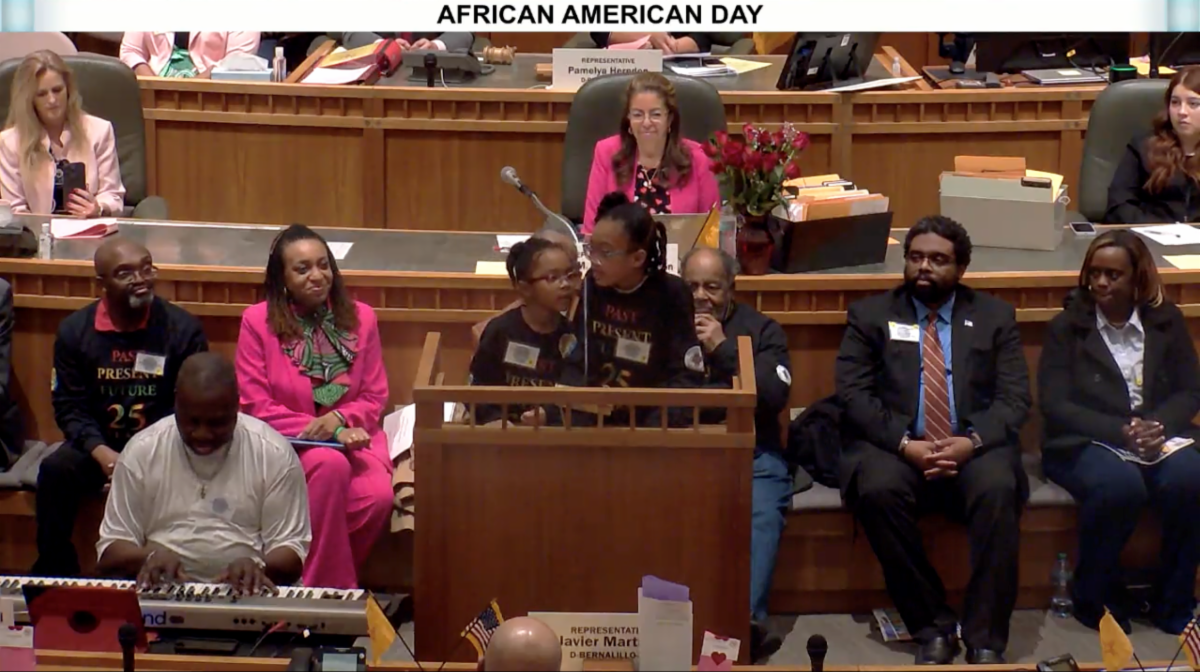Ever wonder about the history of Valentine’s Day? Here’s the CliffsNotes version extracted from Wikipedia:

Valentine’s Day, also called Saint Valentine’s Day or the Feast of Saint Valentine, is celebrated annually on Feb. 14. It originated as a Christian feast day honoring a martyr named Valentine, and through later folk traditions it has also become a significant cultural, religious and commercial celebration of romance and love in many regions of the world. The 8th-Century Gelasian Sacramentary recorded the celebration of the Feast of Saint Valentine on Feb. 14. The day became associated with romantic love in the 14th and 15th centuries, when notions of courtly love flourished, apparently by association with the “lovebirds” of early spring.
So to all your lovebirds, Happy Valentine’s Day!
ELECTED STATE SCHOOL BOARD?
GOING BACK TO THE FUTURE IS NO FUTURE

Senate Joint Resolution 3, sponsored by Sen. Bill Soules (D-Doña Ana), proposes a constitutional amendment that would take us back to the future minus the DeLorean. If approved by the Legislature, the proposal would be placed on the November 2026 ballot for voter consideration and, if approved, would go into effect in 2028. The bill would re-institute a partly elected and partly appointed State School Board, which, in turn, would select a State Superintendent of Education.
Terri Cole, Chamber President and CEO, was in the Senate Rules Committee this morning to oppose the measure:
“We respectfully oppose this legislation because it would inject more politics into public education, and that’s the last thing we need. Putting a large, partially elected group of people in charge of our state’s education system is a recipe for more division and acrimony. Local school boards across America are under fire for governance issues – many local boards are hotbeds of political chaos – and they routinely lose focus on student needs and outcomes. Why would we want a similar situation at the state level?
“Please recall, New Mexico once put an elected body in charge of utility regulation in our state – and for many of the same reasons we’re talking about a state school board today, we ended up with a daily cocktail of dysfunction and poor decision-making. And, rightly so, we retreated from that model.
“We also want to emphasize that this resolution does NOT adequately protect public charter schools. It would eliminate the current state charter school authorizer, which is performing VERY WELL.
“Finally, the number of adult decision-makers is not driving students’ unacceptably low academic performance. This resolution is not going to fix what’s broken. Let’s not advance a so-called solution that hasn’t worked before and won’t again.”
In fact, in 2003 New Mexico voters threw out the old system of an elected state board of education precisely because it was political, sluggish, ineffective and dysfunctional. Why we would want to go back to this model that didn’t work is difficult to fathom. Supporters point to the turnover in appointed secretaries of Public Education, and while that is unfortunate, there is no evidence that this model works better in terms of improving student success. For example, both Mississippi and Louisiana have made giant strides in improving student outcomes. They have different governance models. It’s not the governance model that makes a difference; it’s the focus on students by providing appropriate intervention and support. Legislation being carried by Soules to improve math outcomes and by Sen. President Pro Tempore Mimi Stewart (D-Bernalillo) on literacy are good examples of what needs to be done to support students. Bottom line: It should be all about the kids, not the adults.
Also in opposition were representatives of the Public Education Department, NewMexicoKidsCAN, Public Charter Schools of New Mexico and the Public Education Commission. The latter is responsible for governing state-chartered charter schools and is doing a very good job. This commission would be eliminated if SJR 3 were to pass, which would dilute the focus on the success of charter schools, not a desirable outcome.
Because Soules was chairing the Senate Education Committee meeting at the time this bill was heard, the Rules Committee chose to take public comment in support, then roll the measure over until next week so Soules could participate. Apparently, many supporters of the measure left because they thought the constitutional amendment was not going to be heard today. Whether they might be allowed to testify later is unknown. We’ll keep you posted.
Below is a letter sent to the committee by Del Archuleta, who chaired the old elected State Board of Education. Del is also a past chair of the Chamber’s Board of Directors and is currently the chair of the Chamber’s Education Bold Issues Group. He has unique insights into the problems of the old elected board very worth considering.
Here’s what Archuleta has to say:
Honorable Senate Rules Committee Members:
I sincerely appreciate the opportunity to address SJR3, which you will be hearing tomorrow morning (Friday, Feb. 14). I am unable to testify tomorrow morning, but I wanted to share my thoughts with you.
The subject matter of the joint resolution is something that is near and dear to my heart. In fact, I had the opportunity to serve on – and chair – New Mexico’s previous state board of education before it was dismantled in 2003. Even as the chairman of that board, I believed then – as I continue to believe today – that the state school board model is a poor form of education governance, especially for a state as diverse and large as New Mexico. This was confirmed by my experience on the board, which I will elaborate on in this letter, as well as in my study of how the model has been used elsewhere in the country as part of a “blue ribbon task force” commissioned by the Greater Albuquerque Chamber of Commerce in 2000.
I understand how one might think that a state school board made up of representatives from individual districts would be effective in reflecting strategic input from all corners of the state to shape and implement state educational policy. However, my experience was that it was very difficult to get such a large board to tackle the important statewide issues; narrow and parochial interests dominated. As such, very little meaningful progress was made by our state school board in the past. And as a result, our students suffered under this form of governance.
In my experience, the individual board members I served with were perfectly nice people, all serving with good intention. But when we convened as a board, we were highly ineffective and did not meet the high purpose and responsibility given to the institution. When it was time for us to consider state education policy, many of our meetings devolved into political infighting, and it was very difficult to get some board members to focus on statewide issues or strategies – as opposed to their own “district” needs or issues. In fact, the state superintendent was often compromised by board members who sought to micromanage the process. We had little or no ability to move quickly on important issues because of the many stalemates that developed. To say that the state school board was “sluggish” and “ineffective” compared to many other boards I have had the pleasure to serve on in my career would be a major understatement.
In our education system, we need responsiveness, agility and the stamina to deliver opportunity to every single child in this state. What we do not need is to inject more politics into public education, which is exactly what SJR3 would do.
The Public Education Department needs to be in the governor’s Cabinet, no matter who sits on the fourth floor. The PED needs the flexibility to do what is right to serve our kids and partner across agencies to deliver innovation and progress.
The Greater Albuquerque Chamber and I believe every child in this state deserves a chance to achieve their dreams, and our chance of doing that is much better under the current model of governance. Please do not let SJR3 on the ballot. It will be a setback for our students for generations.
I’d like to close with a quote from an impressive principal who met with our blue ribbon task force when we were visiting Philadelphia during our studies. She said to us:
“We finally started to achieve educational success when we started doing what was right for our kids instead of what was convenient for the adults.”
In retrospect, that’s all we really need to know about doing the right thing for our children.
Thank you for your service and consideration.
Respectfully,
Adelmo (Del) Archuleta
Former member and chairman of the New Mexico board of education
SENATE OKS BEHAVIORAL HEALTH PACKAGE,
SENDS IT ON TO THE HOUSE

A major step in rebuilding the state’s behavioral health system was taken today when the Senate passed Senate Bills 1, 2 and 3 to the House. Here’s a quick rundown on what the bills do:
- SB 1 establishes a $1 billion trust fund that will receive contributions over the next two to three years to bring the corpus to $1 billion. The fund will be invested by the State Investment Council and should produce at least 5% Return on Investment, thereby spinning off $50 million per year that can help sustain behavioral health services. With the 3-1 match ratio from Medicaid funds, the $50 million can be leveraged to produce $200 million per year. Passed Senate 37-5
- SB 2 provides $200 million from the general fund to jump-start 23 program areas and projects for substance abuse treatment, homelessness assistance and other services. Money for developing regional plans is also included. Passed Senate 37-4.
- SB 3 provides for establishing regional districts that will be responsible for project planning, implementation and reporting measurable results. The plans must include five projects that are most important to closing the gap between community needs and service delivery. The Administrative Office of the Courts (AOC) will coordinate standing up the regional districts, and then an executive committee will oversee implementation and reporting. Passed the Senate 37-5.
There was significant debate on SB 3, which is the bill that establishes guardrails and accountability. The framework established in the bill is a bottom-up approach so that plans and programs are reflective of the unique needs of each regional district. Initially, the districts will likely be the 13 judicial districts, but this could be modified and reshaped as experience is gained. All three branches of government collaborated in developing these bills and will continue to do so as the plans and programs are rolled out. As Minority Leader Bill Sharer (R-San Juan), cosponsor with Majority Floor Leader Peter Wirth (D-Santa Fe) on SB 3, observed, what we have now is a rudderless ship. SB 3 installs the rudder.
Sen. Jay Block (R-Bernalillo and Sandoval) said that in 2013 the state’s behavioral health system was decimated, and the state has never been the same, it’s worse. Having had family with substance-abuse issues, Block opined that the state must make huge investments and provide treatment to people who are hurting. “People on the streets have value, and I hope this helps get their lives back on track.” We’re pretty sure that’s a widely held sentiment.
Sen. George Muñoz (D-Cibola, McKinley & San Juan), chair of the Senate Finance Committee, pointed out that over the last three years, the state has spent $2.4 billion and the needle hasn’t moved, and so a different approach is needed. Wirth agreed, saying “We can pass all the bills (on crime) that we want, but we have to have places to send people that need help.” Currently, for nonviolent offenders, their cases are usually dismissed and they’re placed back on the street with no assistance, in part contributing to the catch-and-release dilemma.
Sharer agreed with that; however, in a subsequent press release, he said, “Make no mistake, this investment alone does not solve our state’s rampant crime crisis. Addressing behavioral health is one small piece of our otherwise broad and increasingly worse crime crisis; it is imperative that we also pass accompanying legislation that directly focuses on holding criminals accountable for their actions.” He announced that Senate Republicans would soon be announcing a “major crime package.”
There was limited debate on SB 1 and zero debate on SB 2. Wirth acknowledged that there might be some further “tweaking” of the bills on the House side in response to the governor, House members and a friendly amendment that Block wishes to have included in SB 3. We’ll continue to track this legislation and keep you posted.
SCHOOL TEST RESULTS SHOULD BE TIMELY
– SENATE ED AGREES, PASSES SB 247 9-0
If you take a test, you want the results quickly, right? That’s because results determine what you do next, whether the test shows you need medication for an illness, a new battery for a hard-starting vehicle, or less salt in a recipe.
And getting results for how our students are doing in reading, math and science is no different. Their test results let them, their parents and especially their teachers know where they are academically, as well as what needs to be done to get/keep them on a path to success in college, career and life.
This morning the Senate Education Committee took up Senate Bill 247, Publication of School Assessment Results, sponsored by Sen. Gabriel Ramos (R- Grant, Hidalgo and Luna) and Rep. Rebecca Dow (R-Doña Ana, Sierra & Socorro). The bill is a simple one that “requires the Public Education Department (PED) report on specific performance and trend data from department-approved summative assessments for science, math, and English language arts, by Sept. 1 of each year. It also requires these results to be published on a website in a user-friendly format.”
Education is one of the Chamber’s Bold Issue Group initiatives, and D’Val Westphal, executive vice president of policy and programs, testified in strong support of the bill:
“There’s a well-known idiom that ‘you can’t really know where you’re going until you know where you’ve been.’ That’s especially true when it comes to our students’ academic progress.
“And yet every fall we expect our school administrators, teachers, parents and students to fly blind into the new school year, going months without proficiency results. That’s patently unfair and sets everyone up to fail – students who need extra help don’t receive it, students who are excelling hurry up and wait to advance, and the months go by.
“And we would point out the Legislative Education Study Committee analysis shows many states don’t just meet, but beat, the proposed Sept.1 deadline to publish statewide summative assessment results for English Language Arts, math and science. If Florida, Tennessee, Texas, Indiana, Louisiana and Georgia can release test results before August, there should be no excuse for New Mexico not to as well.
“To improve student proficiencies, our educators, parents and students need this information. They deserve it. It’s being done in other states, and it should be done here. Please pass SB 247. Thank you.”
FYI, PED released last year’s test results on Dec. 19, just in time for winter break.
Amanda Aragon, executive director of NewMexicoKidsCAN, served as Ramos’ expert witness during the hearing, which saw zero opposition to the measure in person, online or from the committee.
Joining the Chamber in support were:
- Public Charter Schools of New Mexico. Lobbyist Carrie Robin Brunder said “assessment data is no good if it’s late” and it allows our leaders to make better decisions at schools and in the Legislature.
- Stan Rounds, executive director at New Mexico Coalition of Educational Leaders, who said “data is important. Timing is important also. We’ve been frustrated as districts do not have testing results for months and months and months and months. This is a step in that direction, and we think it’s something we need to look at.”
- Eli Casaus with Teach+, who shared teachers “need data to respond more efficiently and effectively to student needs and provide families with a clearer picture of their child’s academic progress. Timely and transparent assessment data is critical for educators, families and policy makers.”
The committee clearly agreed, giving SB 247 a unanimous 9-0 “do-pass” vote. It’s headed to Senate Health and Public Affairs next, and we’ll be there to let you know all about the testimony, discussion and vote.
HOSPITAL PRICE TRANSPARENCY BILL
SIMPLY DUPLICATIVE, INFLEXIBLE

Health and Human Services Chair Elizabeth “Liz” Thomson (D-Bernalillo) sat on the other side of the dais today and presented House Bill 263, the Hospital Price Transparency Act.
HB 263 would require hospitals to post information on their public websites to disclose pricing, billing codes and other detailed information for all items and services provided in inpatient and outpatient settings. It also provides penalties on New Mexico hospitals for violating the act and allows patients to bring civil action against hospitals.
The Chamber opposes this legislation, as there are already federal requirements in place. The proposed methodology in HB 263 is very different from the federal rules, overlapping federal procedures and creating new burdens without generating any new tangible benefits for New Mexicans. At the same time, the legislation threatens to increase health care and hospital costs by establishing new hoops to go through.
J.D. Bullington relayed the Chamber’s opposition to the legislation, saying,
“The new price posting framework in HB 263 is more strict than federal policy, and it does not adequately accommodate our economic, regional and local market pricing flexibilities afforded through federal rules. And the analysis points out that there are numerous technical, logistical and definition issues throughout HB 263 that will complicate compliance and enforcement at the state level.”
As if to underscore the Chamber’s concerns about increased litigation and unnecessary costs for hospitals, the only supporter in the room represented the New Mexico Trial Lawyers association.
The bill passed unanimously 8-0 and heads to House Judiciary next.
STOP, LOOK & LISTEN FOR RAILROAD EQUIPMENT
SURVIVES HIJACKING ATTEMPT

Hijack – verb
hi·jack ˈhī-ˌjak
hijacked; hijacking; hijacks
2 a: to take or take control of (something) as if by hijacking
-Merriam-Webter.com
This afternoon the House Judiciary Committee heard House Bill 160, Stop, Look and Listen for Railroad Equipment, sponsored by Reps. Patricia A. Lundstrom (D-McKinley), D. Wonda Johnson (D-McKinley & San Juan), Tara L. Lujan (D-Santa Fe), Raymundo Lara (D-Doña Ana) and Art De La Cruz (D-Bernalillo). The bill was almost a victim of a Great Train Robbery in the form of an unfriendly committee amendment/substitute from committee member Rep. Matthew McQueen (D-Sandoval & Santa Fe). That effort was thankfully tabled on an 8-3 vote. The bill in its original form, which the Chamber supports as a common-sense public safety measure, received a “do-pass” 10-1 vote, with McQueen the lone “no.”
First, here’s what this smart bill does:
Currently at railroad crossings, only trains have the right-of-way over all other traffic. HB 160 would add “other on-track equipment” at all railroad-highway grade crossings. “Other on-track equipment” is “any car, rolling stock or other device that alone or coupled to another device is operated on stationary rails.” The bill would require all drivers, including school bus drivers and drivers carrying hazardous materials, to abide by certain stopping distance requirements when approaching “other on-track equipment,” not just trains.
Chamber President and CEO Terri Cole voiced support for the measure when it was heard in its first committee:
“This is common-sense legislation to help protect both the public and train equipment operators. There has been an increase in accidents and injuries resulting from failure to stop, look and listen for any equipment operating on the rails. This measure should help improve safety.”
Now, here’s what that substitute version wanted to add:
A requirement that all on-track equipment blow its horn a quarter of a mile out from a crossing.
That might seem like a simple request, right?
It’s a lot more complicated than you might think. Lundstrom had an expert in the field on hand to explain why, Jeff Joines, director of government affairs for the Brotherhood of Maintenance Way Employees (a national union representing the workers who build and maintain the tracks, bridges, buildings and other structures on the railroads of the United States). He explained that 39 other states have adopted the language in HB 160, and railroad operators need continuity across the country to operate safely.
“We haven’t varied in this at all,” he shared. “That’s why it’s important to have a clean bill” without such amendments.
In addition, Lundstrom’s original bill “legislates the responsibility of vehicle operators” (drivers on the road should stop, look and listen before approaching/crossing railroad tracks) whereas the substitute legislates the responsibility of the locomotive or equipment on the track. Joines said expecting train and equipment operators to keep track of different rules for different states is a recipe for confusion.
It’s also a recipe to put liability on the train crews in the case of an accident – forget to blow the horn, and you’re on the hook.
There’s no question that virtually anything coming down a train track, be it a locomotive or a maintenance vehicle, is much bigger than any vehicle on the road and guaranteed to win in a collision. And that’s why the Chamber supports the common sense in HB 160 in its original form and as passed, something we’ve all been taught since an early age, and that is to stop, look and listen before approaching or crossing a railroad track.
HB 160 is headed to the House floor – here’s to it avoiding further hijacking attempts and making to the governor’s desk.
MORE HEALTH CARE COMPACTS MOVING IN HOUSE

We have reported to you several times on the various health care licensing compacts that are moving through the House and Senate. Today, House bills 243 and 242 cleared the House Health and Human Services Committee on unanimous votes, passing 9-0. HB 242 addresses psychologists, and HB 243 addresses medical doctors. Both bills now move on to the House Judiciary Committee.
J.D. Bullington spoke on behalf of the Chamber, telling legislators, “We all know how important attracting mental health professionals is as we wrestle with rebuilding the state’s behavioral health system. Both of these bills offer answers to how we attract these professionals to New Mexico.”
There are nine different bills that would make it much easier for healthcare professionals licensed in other states to care for New Mexico patients, including via telehealth. All bills together cover these medical professionals:
- physicians,
- physician assistants,
- psychologists,
- counselors,
- dentists and dental hygienists,
- emergency medical personnel,
- audiologists and speech therapists,
- physical therapists
- and occupational therapists.
Fred Nathan, founder and executive director of Think New Mexico, has spearheaded an effort this year to get New Mexico into these various medical and health care compacts. He and others say approving these nine compacts is the single most impactful thing we can do to address our state’s health care shortages. The results of an existing compact prove it works.
According to Think New Mexico, since 2003 New Mexico has been one of 40 states in the Nurse Licensure Compact, which grants nurses a multi-state privilege to practice in other compact states. As many as 80% of the nurses at some New Mexico hospitals, especially in rural and border areas of the state, would not be practicing here but for this compact.
Yet New Mexico is one of only five states that has joined two or fewer interstate compacts. By contrast, our closest neighbors have adopted five or more interstate compacts — Arizona, six; Colorado, 10; Oklahoma, eight; Utah, nine; and Texas, five.
Nathan told legislators today that this makes New Mexico a donut hole in the region. And not one of the good donut holes, either.
Rep. Jenifer Jones (R-Doña Ana, Hidalgo & Luna) is a retired oncology nurse, and she pointed out that New Mexico is a net exporter of medical professionals. She supported both bills, but she cautioned that New Mexico has more work to do to keep doctors in our state. These compacts work both ways, and doctors from our state could continue to leave to other states. But that’s not a new problem!
You can get involved by sending a message to your own legislators by using this link from Think New Mexico’s website. With it, you can easily send e-mails to the governor, lieutenant governor and your senator and representative. The system will figure out who they are for you and help you write an e-mail supporting these nine major health care worker interstate compacts.
IN THE JOINT SESSION

African American Day Celebrated
Both chambers gathered today just after noon to recognize and celebrate African American Day.
Rep. Pamelya Herndon (D-Bernalillo) served as the presiding officer for today’s special events.
Rep. Janelle Anyanonu (D-Bernalillo) delivered the opening remarks, observing the significant contributions of African Americans in our state, dating back to 1539.
Today’s event marks the 25th anniversary of African American Day at the Legislature.
The keynote speaker was Dr. Carissa Colbert, a dynamic leader who has had an impact locally, nationally and even on an international level. She told the Chamber about Estevan de Moore, an African American who was among the first non-indigenous people to step foot in New Mexico and who played a significant role in early interactions between Zuni and Spanish people.
And the Buffalo Soldiers contributed to American expansion in the Southwest, finding hope in New Mexico amidst deep racism elsewhere.
The afternoon was topped off with a beautiful and touching musical performance by sisters Kendra and Tasha Crawford, fourth- and third-graders at Cochiti Elementary School. Rep. Herndon closed the ceremonies, saying “We’ve learned many things, but most of all that inclusivity must be at the forefront of all our work.”
SIGNING OFF FROM SANTA FE

A little bit of everything today. We’re very pleased to see the behavioral health package on track. If/when the criminal competency passes, then it’s vital to have a strong behavioral health system so there are tools for the judiciary to use other than putting people back on the street. Tomorrow, we expect the House will take up House Bill 8, the public safety package (which contains the criminal competency piece of the puzzle). House committees meet in the morning and the House in the afternoon at 2. The Senate is off until Monday. So, no football (are you having withdrawals?) BUT a plethora of President’s Day sales (oh yippee). Shop ’til you drop. We’ll see you tomorrow evening, and you have a wonderful evening yourself.




